Contents
Description
Squid is a commercial cephalopod mollusk. Squids (lat. Teuthida) – belong to the order of cephalopods, unlike octopuses, they have ten tentacles. The squid is an excellent swimmer capable of covering long distances. They move with the help of a kind of jet engine: they have a special hole on their bodies, from which the cephalopods throw a stream of water.
Among the squid, there is one of the largest mollusks, the architeutis, with its tentacles reaching sixteen meters. Architeuthis (giant squid) (Latin Architeuthis) is a genus of deep-sea squid that makes up an independent family of Architeuthidae. This is the most powerful invertebrate animal that can successfully measure strength with the sperm whale.
In the Far Eastern seas, near the Primorsky coast and Sakhalin, the Pacific squid is mainly found. In the sea, this mollusk is colored pale greenish blue. But it is worth removing it from the water, as the color immediately changes and acquires a reddish-brick, and sometimes brown color. The weight of squids living in the Far Eastern waters is small – up to seven hundred and fifty grams.

In the warm season, the Pacific sardine, Iwashi, lives in the Sea of Japan. It comes to our shores after spawning, reaching the north of the Tatar Strait. And together with Iwashi, schools of squid “visit” our lands, for which Pacific sardine is a favorite delicacy.
Fishing – catch squid
How is squid caught? In some countries, fishing rods with spinners or hooks are used for this. They are caught from the boat; A lure with a large number of hooks is tied to a strong and thin fishing line, ten to fifteen meters long, attached to a short and flexible rod.
But it is worth luring the squids out of the depths of the sea, using underwater and surface light for this, as at a depth of one meter they can be caught with a slingshot. The most successful fishing is at sunset. Larger squids live further from the coast, and smaller ones off the coast.
Having finished catching (catching) squid, it is necessary to send squid for processing faster. Squids are placed in rows in boxes or baskets, with tentacles in different directions, otherwise they can gnaw at each other, and this will disfigure the appearance of the product.
In recent years, the production and consumption of squid in the world of “sea meat” has more than doubled. And the catch of the cephalopod mollusk has grown more than fivefold. Experts believe that squid production can be increased to fifteen to twenty tons per year!
Squid ink sac

All cephalopods have a valuable gift from nature – an ink sac. This is the internal organ of the squid, located in the mantle. The ink contains organic dye. The shade of ink in cephalopods is not the same: in cuttlefish it is blue-black, and in squid it is brown.
Observations have shown that the ink thrown out by the cephalopods does not dissolve immediately, for ten minutes or more they hang in the water as a dark compact drop. But the most striking thing is that the shape of the drop resembles the outline of the animal that threw it away. The predator grabs this drop instead of the escaping victim. Then it “explodes” and shrouds the enemy in a dark cloud, while squids, using this cover, hide from pursuit.
Using an ink bag
Using modern technology, paint can be obtained from the contents of the ink sac. To do this, they do this: the bags are removed from the insides, rinsed in sea water and dried in the sun. The dried bags are crushed and boiled, after which the liquid is filtered, then the paint is released.
These are the values that the ink pouch contains! But you need to handle it very carefully, if you damage it, the paint will leak out, and the squid meat will darken.
People who deal with live squid, first of all, should take care of their eyes, since the colored liquid, getting on the mucous membrane of the eye, causes severe irritation.
Composition and calorie content
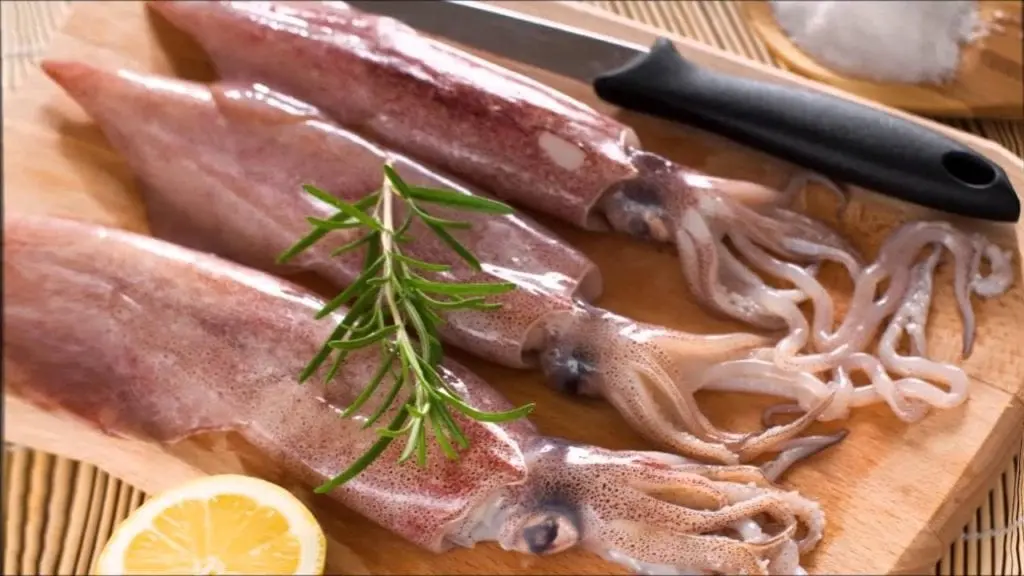
Squids are nutritious and healthy. Cephalopods are truly a real storehouse of protein substances. There are many extractive substances in the tissues of the squid body, which contribute to the secretion of digestive juices and give a peculiar taste to culinary products made from squid.
In terms of chemical composition, raw squid tissues are distinguished by a large amount of water and a low fat content; however, some researchers argue that squid living in the waters of southern Sakhalin are richer in fat. Dry body tissues of squid contain (in percentage):
- proteins 81.4,
- fat 5.8,
- glycogen up to 1.4,
- mineral substances 10.2.
Scientists claim that the body tissues of squid contain B vitamins and trace elements, and vitamin C.
How to eat squid
The muscular parts of the head, torso, and tentacles of the squid can be used to prepare dried foods. Dried squid is marketed as thin flakes that resemble vermicelli.
To prepare their carcass of dried squid on machines, cut into thin strips, which are then packed in cardboard boxes, paper or cellophane bags. In addition to freshly dried products, salted squids are also prepared.
Benefits of squid
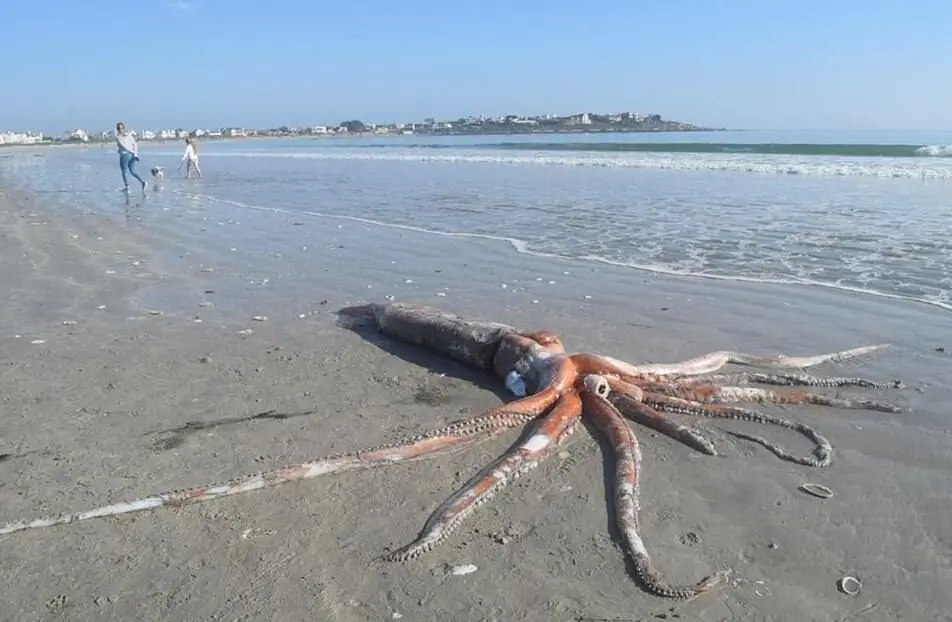
Squid meat is an excellent source of complete proteins. So, 100 g of these shellfish contain up to 18 g of protein. This is no less than the same amount of beef or fish.
Proteins serve as the main material for building cells and tissues of the body, with their help enzymes and hormones are formed.
Proteins are a valuable supplier of natural amino acids (for example, methionine, lecithin) – irreplaceable “creators” of new durable tissues and reliable “restorers” of worn out and damaged ones.
Squid contains almost all vitamins necessary for our body (PP, C, group B), iodine, iron, phosphorus, manganese, calcium. Squid meat surpasses other seafood delicacies in potassium content: it is needed for the normal functioning of all muscles, including the most important one – the heart. Potassium helps the heart beat calmly, rhythmically and evenly. The mineral regulates the water-salt balance in the body, preventing edema and increased blood pressure.
In addition, squid contains virtually no fat. That is why dishes from them can be safely included on fasting days and diets.
Squid are an excellent source of copper, which is essential for the formation of hemoglobin and collagen in the body.
The phosphorus in squid plays an important role in the formation and maintenance of healthy bones and teeth. In addition, it is involved in tissue growth and regeneration, and also helps maintain normal blood pH levels. Finally, phosphorus is one of the components of cell membranes.
Squid contains a large amount of zinc. It is involved in immune responses, the production of genetic material, and wound healing.
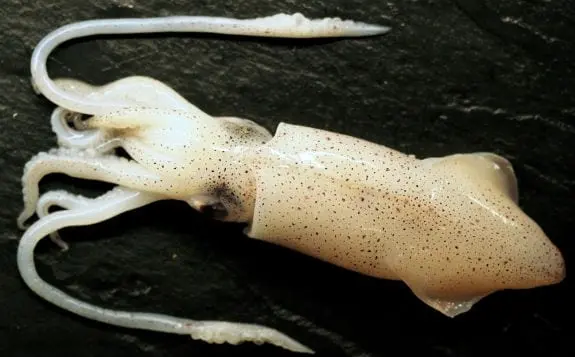
Squid are an excellent source of magnesium, which is involved in bone development, protein formation, enzymatic actions, muscle contraction, dental health, and the immune system. It also plays an important role in energy exchange and transmission of nerve impulses.
Vitamin E in squid protects the membrane around cells, in particular red and white blood cells (cells of the immune system).
Vitamin C, which is present in squid, is simply indispensable for the body, namely for the health of bones, cartilage, teeth and gums. In addition, it protects the body from various infections, promotes the absorption of iron and accelerates tissue healing.
Harm and contraindications
Recently, more and more official studies have appeared confirming the high concentration of mercury and other heavy metals in fish and seafood. They accumulate in the water due to industrial emissions, which only increase every year. According to the Environmental Protection Agency, squid is one of the few foods with minimal potential to accumulate mercury.
But shellfish belongs to the category of the greatest allergens. In many people, squid intolerance has been clinically established, manifested in the form of an allergic reaction.
How to choose and store squid
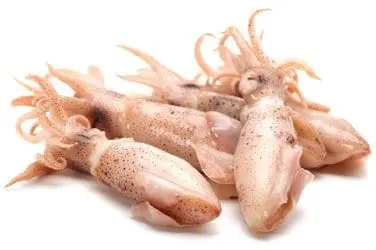
It is best to buy frozen squid. Thawed, especially if the technology is not followed, they taste bitter and do not keep their shape. Basically, it is a marriage that has no nutritional or gustatory value. The carcasses should not be sticky, because this also indicates that the product is defrosted in front of you.
The body is always covered with a film, which, depending on the habitat of the mollusk, can have a different shade – from gray to deep purple. And the meat of all varieties has a snow-white hue. Any other color is a signal confirming poor quality. Theoretically, you can buy peeled squid, but this will immediately spoil the taste of the final dish, since such meat is absolutely tasteless.
There is a little secret that can be guided when choosing these seafood: the smaller the size, the tastier the meat.
You only need to store squids in the freezer. They cannot be thawed and frozen again unnecessarily.
How to quickly peel squid
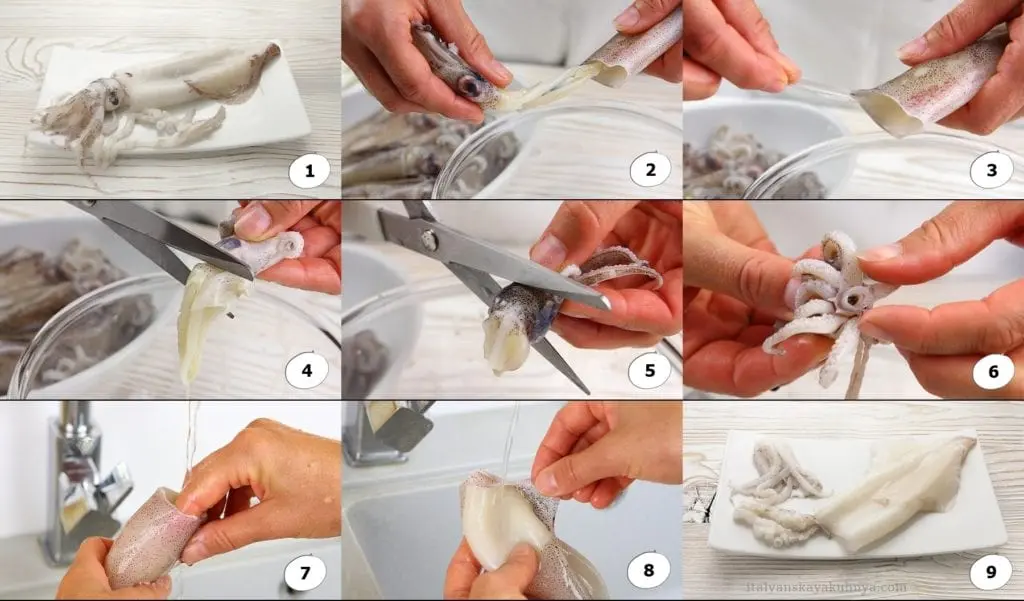
To quickly clear them from the film, you do not need any special tools. It is enough to put the frozen shellfish in a bowl and pour boiling water over it. Due to the temperature difference, almost all the film on its surface curls up and is easily peeled off. The one that has not moved away can be easily removed by hand.
Then you need to drain all the water and rinse the carcass under running water. You also need to remove all the insides of the squid, including the transparent spine, and rinse it again. If, after all these processes, the meat has not completely defrosted, it should be poured with hot water (but not boiling water) and left for a few minutes.
How to cook delicious squid
Today there are a huge number of recipes based on squid. They are suitable for both daily and holiday menus.
How to fry
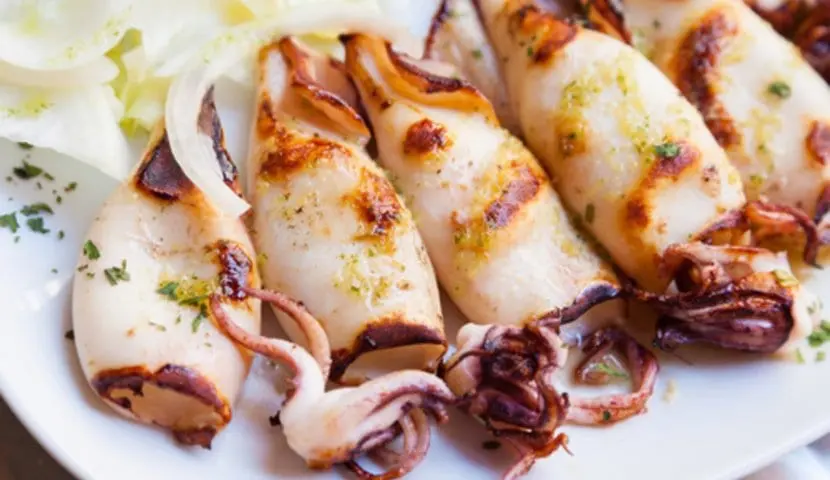
If there are no problems with the gastrointestinal tract, then periodically you can pamper yourself with fried squid.
This will require:
- frozen squid – 300 grams;
- soy sauce – 5 tablespoons;
- salt to taste;
- dry white wine – 120 ml;
- grated ginger – to taste;
- dill – 2-3 branches;
- olive or sunflower oil – 3 tablespoons;
- sugar – 1 tsp;
- juice of half a lemon.
Preparation
First of all, we defrost the squid, rinse thoroughly and remove the film from them. We cut the carcass into 4-6 parts, depending on its size. In a separate bowl, mix the wine, soy sauce, lemon juice, grated ginger, sugar, add finely chopped dill. We mix everything until the sugar is completely dissolved. We immerse the squids in the resulting marinade and leave in the refrigerator for 60 minutes. After that, we heat the pan, pour oil and put the squids on it. Fry over medium heat for 10 minutes.
How to boil
The best way to cook squid is to boil them. To do this, cut meat or a whole carcass must be put in salted water with the addition of black pepper and bay leaves. You need to cook it no longer than three minutes, otherwise it will be rubbery. It can be soft again only if cooked for 30 minutes. But in this way its quantity will be reduced by exactly half. After that, you can do whatever you want with the clam – cut it for salads or stuff it.
8 Interesting Squid Facts
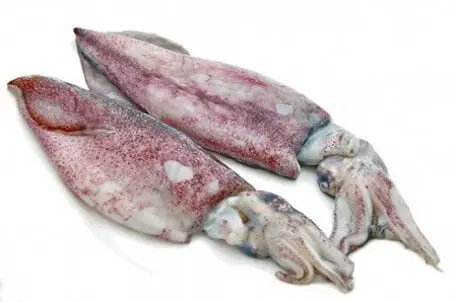
Seafood lovers will be interested in the following information:
- Squids are the least studied inhabitants of the seas, more than 300 species of squid have been officially confirmed, but more than 200 species remain unidentified.
- Among all the cephalopods, which also include cuttlefish and octopus, squid is the most beloved of marine predators.
- It is squid that accounts for most of the diet of many representatives of the underwater world.
- The squids themselves feed on crustaceans and small fish. In the absence of such, they can switch to small representatives of their species.
- If a squid stumbles upon danger in its path, it will emit a pigment very similar to ink.
- Some squids have an amazing ability – they can fly.
- Only dolphins, sharks and whales are ahead of the movement speed of squid.
- The blood of the mollusk is blue, and not one, but three hearts are responsible for the circulation.










Er der meget mere kviksølv i selv ganske små blæksprutter fra det indiske ocean, da de måske lever af krabber, der jo er fundet meget høje forekomster af kviksølv i, når de netop er fanget i det indiske ocean.
Jeg har ingen data på blæksprutter fra det indiske ocean, kun har jeg set data på krabber, hvilket måske er rimelig store ifht. de krabber de ganske små, 8 cm blæksprutter, jeg spiser rigtig meget af.
På forhånd tak.
Mvh
Carsten